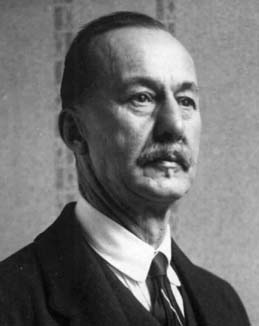
Wilhelm Wirtinger
 المؤلف:
C Caratheodory
المؤلف:
C Caratheodory
 المصدر:
Obituary : Wilhelm Wirtinger, Jber. Bayer. Akad. Wiss. Munchen (1944-1948)
المصدر:
Obituary : Wilhelm Wirtinger, Jber. Bayer. Akad. Wiss. Munchen (1944-1948)
 الجزء والصفحة:
...
الجزء والصفحة:
...
 9-4-2017
9-4-2017
 1252
1252
Born: 15 July 1865 in Ybbs an der Donau, Austria
Died: 15 January 1945 in Ybbs an der Donau, Austria

Wilhelm Wirtinger was born in Ybbs, a town on the Danube about half way between Vienna and Linz.
Wirtinger studied at the University of Vienna, and it was from that University that he received his doctorate in 1887 and his habilitation in 1890. However, the largest influence on the direction of his research came from Klein before he was awarded his habilitation, when he studied at the University of Berlin and at the University of Göttingen.
In 1895 Wirtinger was promoted to a chair at Vienna then, later the same year, he accepted a chair at the University of Innsbruck. Wirtinger returned to a chair at the University of Vienna in 1905.
In 1896 Wirtinger published a work of major importance on the general theta function. In this work Wirtinger combined ideas from Riemann's function theory with ideas from Klein to prove results of great significance. This paper, which he had developed from work begun at Göttingen, brought Wirtinger's name to the fore as a leading mathematician.
Caratheodory writes in [1]:-
However, Wirtinger was not a specialist who only worked on one problem and did not have a sense for the essentials of science. In his lectures he always stressed the historical context and had a remarkable interest in the philosophical basis of mathematics. He was economical with his publications, but every single paper - even if only a few pages long - does not only contain surprising thought of exceptional beauty but also proof that he could combine his perfect geometrical insight with his rare skill of mastering the mathematical symbolism.
Wirtinger's range of mathematics was quite exceptional. Not only did he write beautiful papers on function theory, he also wrote on geometry, algebra, number theory, plane geometry and the theory of invariants. He also wrote several important papers on Lie's translation manifolds and their application to abelian integrals.
This list would make one believe that Wirtinger's range within pure mathematics was very wide but his interests went well beyond pure mathematics. He published results on Einstein's theory of relativity and other areas of mathematical physics. He also worked in statistics and wrote a work on rainbows.
Others taking their summer vacations on the Achensee would have relaxed and taken the chance to have a break from academic work. Not so Wirtinger, who sat and watched the waves on the lake and thought about the mathematical theory which lie behind them. After his holiday he wrote up his results to provide an improved theory of capillary waves.
When Reidemeister was appointed as associate professor of geometry at the University of Vienna in 1923 he became a colleague of Wirtinger. At that time Wirtinger was interested in knot theory and he showed Reidemeister how to compute the fundamental group of a knot from its projection. Wirtinger's method was first published in work of Artin in 1925.
Wirtinger certainly did not lessen his mathematical activity as he grew older. At the age of 71 he wrote the first of a series ground-breaking papers on higher dimensional spaces.
Among the mathematicians who Wirtinger taught while he held the chair at Vienna are Schreier, Gödel, Radon and Taussky-Todd.
Wirtinger received many honours for his achievements. In 1907 the Royal Society of London awarded him their Sylvester Medal. He was the third recipient of the medal which had been previously awarded to Poincaré and Cantor, so indeed this ranked him among the very greatest mathematicians of his day. Among other honours was his election to the Munich Academy in 1931.
Articles:
- C Caratheodory, Obituary : Wilhelm Wirtinger, Jber. Bayer. Akad. Wiss. Munchen (1944-1948), 256-258.
 الاكثر قراءة في 1865to1869
الاكثر قراءة في 1865to1869
 اخر الاخبار
اخر الاخبار
اخبار العتبة العباسية المقدسة


